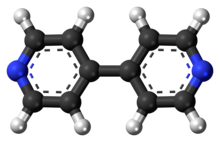4,4'-Bipyridine

| |

| |

| |
| Names | |
|---|---|
| Preferred IUPAC name
4,4′-Bipyridine | |
| Identifiers | |
3D model (JSmol)
|
|
| 113176 | |
| ChEBI | |
| ChEMBL | |
| ChemSpider | |
| ECHA InfoCard | 100.008.216 |
| EC Number |
|
| 3759 | |
PubChem CID
|
|
| UNII | |
CompTox Dashboard (EPA)
|
|
| |
| |
| Properties | |
| C10H8N2 | |
| Molar mass | 156.188 g·mol−1 |
| Melting point | 114 °C (237 °F; 387 K) |
| Boiling point | 305 °C (581 °F; 578 K) |
| Structure | |
| 0 D | |
| Related compounds | |
Related compounds
|
2,2′-Bipyridine Pyridine 4-Pyridylnicotinamide Terpyridine Biphenyl |
Except where otherwise noted, data are given for materials in their standard state (at 25 °C [77 °F], 100 kPa).
| |
4,4′-Bipyridine (abbreviated to 4,4′-bipy or 4,4′-bpy) is an organic compound with the formula (C5H4N)2. It is one of several isomers of bipyridine. It is a colorless solid that is soluble in organic solvents. is mainly used as a precursor to N,N′-dimethyl-4,4′-bipyridinium [(C5H4NCH3)2]2+, known as paraquat.
History
[edit]4,4′-Bipyridine was first obtained in 1868 by the Scottish chemist Thomas Anderson via heating pyridine with sodium metal.[1] However, Anderson's empirical formula for 4,4′-bipyridine was incorrect.[2] The correct empirical formula, and the correct molecular structure, for 4,4′-bipyridine was provided in 1882 by the Austrian chemist Hugo Weidel and his student M. Russo.[3]
Uses
[edit]4,4'-Bipyridine is an intermediate in the production of paraquat, a widely-used herbicide. In this process, pyridine is oxidized to 4,4'-bipyridine in a coupling reaction, followed by dimethylation to form paraquat.[4]
Reactions
[edit]The reducing agent is N,N'-bis(trimethylsilyl)-4,4'-bipyridinylidene is produced by reduction of 4,4'-bipyridine in the presence of trimethylsilyl chloride (Me = CH3):
- NC5H4C5H4N + 2 Li + 2 Me3SiCl → Me3SiNC5H4C5H4NSiMe3 + 2 LiCl
The silylated derivative, which is red, is used in salt-free reductions.[5]
4,4′-bipyridine forms a variety of coordination polymers.[6]
References
[edit]- ^ See:
- Anderson, Thomas (1868). "On the products of the destructive distillation of animal substances. Part V." Transactions of the Royal Society of Edinburgh. 25: 205–216. doi:10.1017/S0080456800028167. S2CID 251577345. Anderson called 4,4′-bipyridine "Dipyridine".
- German translation: Anderson, Th. (1870). "Ueber die Producte der trockenen Destillation thierischer Materien. Fünfter Theil" [On the products of the dry distillation of animal materials. Fifth part.]. Annalen der Chemie und Pharmacie (in German). 154: 270–286. doi:10.1002/jlac.18701540303.
- See also: Fehling, Hermann Christian von, ed. (1890). Neues Handwörterbuch der Chemie [New Concise Dictionary of Chemistry] (in German). Vol. 5. Braunschweig, Germany: Friedrich Vieweg und Sohn. p. 974. See γ-Dipyridyl.
- ^ Anderson gave the empirical formula for 4,4′-bipyridine as C10H10N2. See:
- (Anderson, 1868), p. 209.
- (Fehling, 1890), p. 974 (γ-Dipyridyl).
- ^ Weidel, H.; Russo, M. (1882). "Studien über das Pyridin" [Studies of pyridine]. Monatshefte für Chemie (in German). 3: 850–885. doi:10.1007/BF01516855. S2CID 97065714. The empirical formula for 4,4′-bipyridine (γ-Dipyridyl) appears on p. 856 ; the molecular structure of 4,4′-bipyridine (γ-Dipyridyl) appears on p. 867.
- ^ "Paraquat and Diquat". IPCS INCHEM.
- ^ Tsurugi, Hayato; Mashima, Kazushi (2019). "Salt-Free Reduction of Transition Metal Complexes by Bis(trimethylsilyl)cyclohexadiene, -dihydropyrazine, and -4,4′-bipyridinylidene Derivatives". Accounts of Chemical Research. 52 (3): 769–779. doi:10.1021/acs.accounts.8b00638. PMID 30794373. S2CID 73505603.
- ^ Biradha, K.; Sarkar, M.; Rajput, L. (2006). "Crystal engineering of coordination polymers using 4,4′-bipyridine as a bond between transition metal atoms". Chemical Communications (40): 4169–79. doi:10.1039/B606184B. PMID 17031423.
